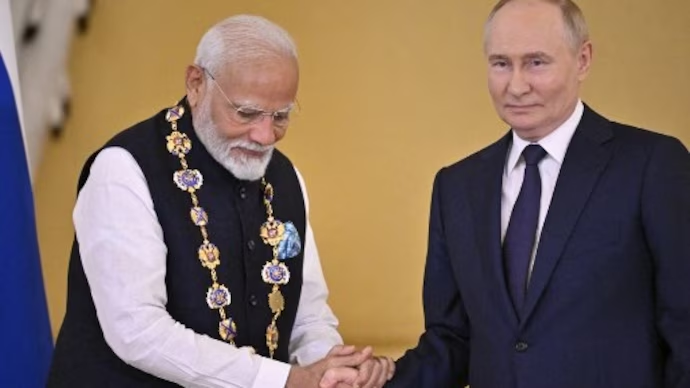Trump’s Tariff Threats May Push India Closer to Russia and China: A Strategic Realignment at the SCO Summit
- MGMMTeam

- Aug 8
- 4 min read
As Donald Trump seeks a return to the White House in 2025, his campaign trail has once again ignited concerns over his deeply protectionist economic vision. Reports indicate that Trump is considering slapping tariffs of up to 60% on imports from major trade partners, including China and India. While Trump’s “America First” rhetoric is not new, the magnitude and direction of his proposed trade policy could have far-reaching consequences for global diplomacy.
India, a key strategic ally of the United States in Asia, now finds itself at a critical juncture. The prospect of punitive tariffs could challenge the fabric of India-U.S. trade relations and force New Delhi to re-evaluate its geopolitical alignments. With the Shanghai Cooperation Organisation (SCO) Summit on the horizon, this moment presents an opportunity—and a dilemma—for Indian diplomacy.

The SCO Summit: A Platform for Strategic Shifts
Prime Minister Narendra Modi’s decision to attend the SCO Summit in Astana, Kazakhstan, marks a significant diplomatic move. His presence at the summit comes at a time when the world is witnessing increased fragmentation and power struggles. Notably, Russian President Vladimir Putin is expected to attend the summit in person after years of being diplomatically sidelined due to the Ukraine war and the pandemic.
For India, the SCO provides a platform to reinforce its relevance in Eurasian politics, especially in the face of new Western economic pressures. The summit offers India a chance to reaffirm its long-standing ties with Russia and engage with China, despite continued border tensions. Modiji’s participation signals India’s commitment to a multipolar world where it refuses to be tied down to any single alliance.
India-Russia Ties: Resilient Amid Sanctions
India’s relationship with Russia has remained steady, even as much of the West has distanced itself from Moscow due to its invasion of Ukraine. India has significantly increased its import of Russian crude oil at discounted rates, making Moscow one of New Delhi’s top energy suppliers. Beyond energy, defense cooperation between the two nations continues to thrive, with India relying on Russian-origin military hardware for its armed forces.
While the West has attempted to pressure India into curbing its engagement with Russia, New Delhi has maintained its stance of strategic autonomy. India has argued that its national interests are paramount and that dialogue and diplomacy—not isolation—are the only viable path toward global stability. In this context, any American move to undermine bilateral trade with India could strengthen New Delhi’s inclination to deepen its Russia ties.
Tensions and Calculations with China
Unlike its relatively stable ties with Russia, India’s relationship with China is far more strained. The 2020 Galwan Valley clash and continued military tensions along the Line of Actual Control have cast a long shadow on bilateral relations. Nevertheless, India has not cut off dialogue with China. Both nations continue to engage within multilateral forums like SCO and BRICS, carefully compartmentalizing their border disputes from broader regional cooperation.
While deepening ties with China is not India’s preferred route, participation in organizations where China plays a key role helps India avoid diplomatic isolation. It also ensures India remains a key voice in shaping narratives in the Global South. Trump’s tariff threats may not directly push India into China’s orbit, but they could accelerate India’s strategic engagement with multilateral platforms that include China.
Modiji’s Calculated Diplomacy in a Changing World Order
Prime Minister Modi has consistently portrayed India as a power that leads from the front, without aligning blindly with any global bloc. Under his leadership, India has cultivated deep defense partnerships with the U.S., built strong ties with Europe, maintained robust energy diplomacy with the Gulf, and preserved its traditional relationship with Russia. This multi-directional foreign policy has helped India expand its global footprint without compromising on its strategic autonomy.
Trump’s possible re-election and the return of a transactional approach to diplomacy may challenge this balancing act. If India is subjected to harsh tariffs or economic restrictions, it may have to recalibrate its partnerships. Modiji’s engagement at the SCO Summit, especially with Putin and other non-Western leaders, demonstrates that India is already preparing for a scenario in which it must hedge its bets.
A Delicate Balance: Navigating Between Powers
India’s foreign policy today is defined by nuance. It does not seek to abandon the West, nor does it aim to embrace the East in full. Instead, it strives to shape a new order where global power is distributed rather than concentrated. The growing unpredictability of U.S. policy—especially under Trump’s influence—only reinforces India’s need to diversify its partnerships.
With the SCO Summit approaching and global tensions rising, India’s choices will resonate far beyond the subcontinent. Whether it leans closer to Russia and China or continues to prioritize Western alignment, the decisions made in this moment will likely define its role in the international arena for years to come.
Conclusion: The Geopolitical Cost of Economic Nationalism
Trump’s aggressive tariff strategy may win him applause from some domestic constituencies, but on the global stage, it risks alienating key partners like India. For a country that has emerged as a critical economic and strategic counterbalance to China, losing India’s goodwill would be a major diplomatic setback for the U.S.
India, meanwhile, will act according to its own interests—as it always has. If the U.S. chooses economic nationalism over strategic cooperation, India will not hesitate to turn toward forums and allies that are willing to engage without coercion. The SCO Summit in Astana may very well mark a turning point in this evolving global chessboard.
(Sources: India Today, Hindustan Times, NDTV)




Comments